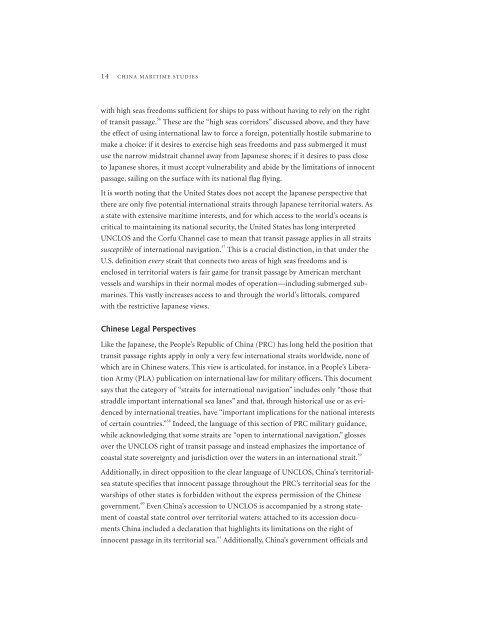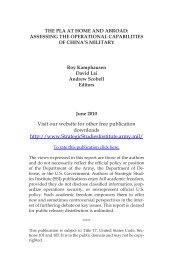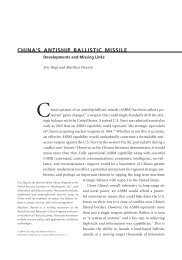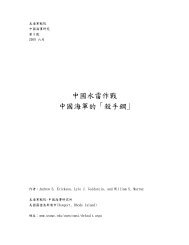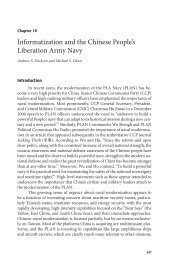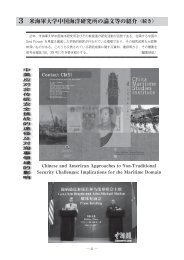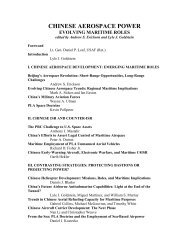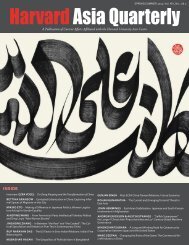Scouting, Signaling, and Gatekeeping - US Naval War College
Scouting, Signaling, and Gatekeeping - US Naval War College
Scouting, Signaling, and Gatekeeping - US Naval War College
Create successful ePaper yourself
Turn your PDF publications into a flip-book with our unique Google optimized e-Paper software.
14 CHINA MARITIME STUDIES<br />
with high seas freedoms sufficient for ships to pass without having to rely on the right<br />
of transit passage. 56<br />
These are the “high seas corridors” discussed above, <strong>and</strong> they have<br />
the effect of using international law to force a foreign, potentially hostile submarine to<br />
make a choice: if it desires to exercise high seas freedoms <strong>and</strong> pass submerged it must<br />
use the narrow midstrait channel away from Japanese shores; if it desires to pass close<br />
to Japanese shores, it must accept vulnerability <strong>and</strong> abide by the limitations of innocent<br />
passage, sailing on the surface with its national flag flying.<br />
It is worth noting that the United States does not accept the Japanese perspective that<br />
there are only five potential international straits through Japanese territorial waters. As<br />
a state with extensive maritime interests, <strong>and</strong> for which access to the world’s oceans is<br />
critical to maintaining its national security, the United States has long interpreted<br />
UNCLOS <strong>and</strong> the Corfu Channel case to mean that transit passage applies in all straits<br />
susceptible of international navigation. 57<br />
This is a crucial distinction, in that under the<br />
U.S. definition every straitthatconnectstwoareasofhighseasfreedoms<strong>and</strong>is<br />
enclosed in territorial waters is fair game for transit passage by American merchant<br />
vessels <strong>and</strong> warships in their normal modes of operation—including submerged submarines.<br />
This vastly increases access to <strong>and</strong> through the world’s littorals, compared<br />
with the restrictive Japanese views.<br />
Chinese Legal Perspectives<br />
Like the Japanese, the People’s Republic of China (PRC) has long held the position that<br />
transit passage rights apply in only a very few international straits worldwide, none of<br />
which are in Chinese waters. This view is articulated, for instance, in a People’s Liberation<br />
Army (PLA) publication on international law for military officers. This document<br />
says that the category of “straits for international navigation” includes only “those that<br />
straddle important international sea lanes” <strong>and</strong> that, through historical use or as evidenced<br />
by international treaties, have “important implications for the national interests<br />
of certain countries.” 58<br />
Indeed, the language of this section of PRC military guidance,<br />
while acknowledging that some straits are “open to international navigation,” glosses<br />
over the UNCLOS right of transit passage <strong>and</strong> instead emphasizes the importance of<br />
coastal state sovereignty <strong>and</strong> jurisdiction over the waters in an international strait. 59<br />
Additionally, in direct opposition to the clear language of UNCLOS, China’s territorialsea<br />
statute specifies that innocent passage throughout the PRC’s territorial seas for the<br />
warships of other states is forbidden without the express permission of the Chinese<br />
government. 60<br />
Even China’s accession to UNCLOS is accompanied by a strong statement<br />
of coastal state control over territorial waters: attached to its accession documents<br />
China included a declaration that highlights its limitations on the right of<br />
innocent passage in its territorial sea. 61<br />
Additionally, China’s government officials <strong>and</strong>


